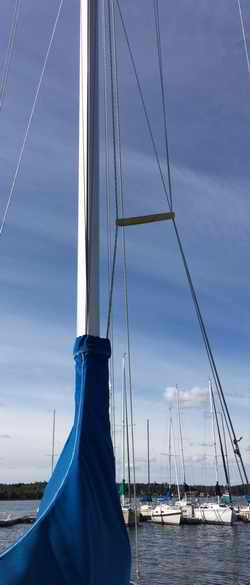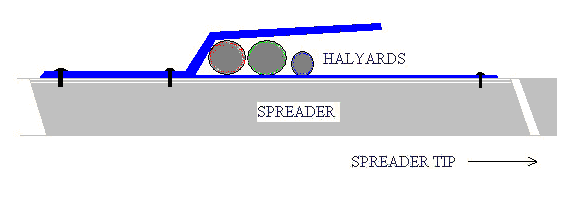| SJ23 Tech Tip F23, (Updated 2006-07-01) Bob Schimmel | |
|
Jib Halyard Storage - on the Pulpit & Spreader. |
|
If
you have hanked on sails these rings are a convenient place
to store
a jib or spinnaker halyard
plus the downhaul line. No more fumbling for them in lumpy water.
Sail changes will be quicker and less frustrating because the
business end of the line is "clearly" in front of you.
You
don't have to go back to the mast or finger along the toe rail under a
loose sail to grab a halyard. There is no longer an excuse for an
errant halyard either. I saw this system on several race boats in
Vancouver, BC and I adopted it on Panache. It is an extremely convenient system to use. The halyards shown
(left to right) are:
 jib
(red), spinnaker (blue), and jib (green). The line clipped to the bottom
is the down haul which I use to control the shape of the
cruising spinnaker by
adjusting the height of the
tack or to add luff tension for a hanked on jib. jib
(red), spinnaker (blue), and jib (green). The line clipped to the bottom
is the down haul which I use to control the shape of the
cruising spinnaker by
adjusting the height of the
tack or to add luff tension for a hanked on jib.
PS: The halyard shackles are now spliced to the line instead of knotted. A splice is less prone to snag. NOTE - Storing a halyard on the pulpit is NOT compatible with roller furling. There is a high probability that the halyard will be snagged and pulled inside the furled jib, resulting in a lock up. It may be difficult to release the line unless you are real careful to unfurl the jib to exactly the same point of snagging. CONSTRUCTION - I bought four 1.25" diameter stainless D rings from a chandler. This size fits easily to your halyard fitting. Lash each ring to the pulpit using light flexible polyester line. This is exactly the same tying a whipping on the end of a line. This way there are no loose ends to reveal how the knot is tied. Slick. After all, you may as well make it look like magic! Tie the knots tight enough so the rings stand upright. This makes clipping a halyard on a ring a one hand operation, which is very convenient when holding a loose sail with your other hand on a heaving deck. 2019 UPDATE - After
installing roller furling on Panache I discovered that a loosely
tensioned halyard clipped to the pulpit could easily get wrapped around the top of a furled jib, locking it
when the top of the halyard goes tight. This wrap is difficult to see from the cockpit or the foredeck. For this
reason I now store only the spinnaker halyard to the pulpit and keep it very tight.
The primary jib halyard is always clipped on the furler and the spare jib halyard for the stay sail (Tech
Tip F36) is pulled up
the mast with a 1/8" messenger line to retrieve it. This has the advantage of reducing the weight aloft. The bulk of the halyard is
stored in a coil in the cockpit bag. |
|
|
HOOK to ELIMINATE HALYARD MAST SLAP.
A
slick device that I saw on a Folkboat 26 with external halyards consisted of an outward facing
hook, mounted horizontally about half way out on a spreader. One hook
was installed on the aft side for the main halyard and the other hook was
installed on the fore side for the jib and spinnaker halyards. CONSTRUCTION - A wood hook can be fastened to the aluminum spreader on a SJ23 using SS screws. A stainless steel hook can be fastened with aluminum pop rivets. Regardless of the material, shape the base of the hook to conform to the 1.25" OD spreader. Use a marine sealant between the base and the spreader to prevent movement and galvanic corrosion. Be sure to make the throat of the hook slightly larger than the diameter of your thickest halyard, when it was new. This prevents jamming. No sense creating a problem when you are trying to solve one. A word of caution about the aft halyard hook for an SJ23, the mainsail luff will chafe on it with the boom fully out which is why you might want to install a wear pad on outside of the bracket. OPERATION - It is quite easy to insert a halyard by pulling it tight and press it lightly against the
outer end of
the spreader, then slide it into the open hook. Maintain a little tension
while you tie the bottom off. The
halyard will remain well clear of the mast for its entire length,
preventing that irritating slapping noise. This system is much more effective than
tying the end of a halyard to the toe rail as there is a wider angle with
the upper portion of the mast and it leaves the side deck
clear for walking. When not under sail it is OK to set
multiple halyards in the same hook as shown above. If you want each line
held independently then install multiple hooks. Your choice. The best part
of it all is that I'm told the halyards never foul on the hooks. |
|
|
Return to Tech Tip Index. . . . . . . . . . . . . . . Have a Question? |
|
 Some people love the noise of halyards
slapping against a mast in a marina. Others hate it, myself included. In the first few days of a new
season it may be music to your ears, BUT I hate
the noise at night because I can't sleep with the racket. Neither
can anyone else. So why be so inconsiderate of others by depriving them of their sleep! One of the
favourite techniques of silencing a halyard is to flip it around the end of a spreader, then snug it
up at the bottom. Another method is to pull the tight halyard away
from the mast with a bungee cord to the outside shroud. They both
work to some degree, but flipping it against a strong wind can be difficult and chasing a bungee cord that has slipped up the rigging can
be amusing to others. A third technique is to clip the bottom of the halyard to
some point away from the mast base, keeping the line away from the mast. Any of these techniques will also save the anodizing on the mast. You may laugh at this but look at the spreaders below that were worn through from a SS halyard rub.
Some people love the noise of halyards
slapping against a mast in a marina. Others hate it, myself included. In the first few days of a new
season it may be music to your ears, BUT I hate
the noise at night because I can't sleep with the racket. Neither
can anyone else. So why be so inconsiderate of others by depriving them of their sleep! One of the
favourite techniques of silencing a halyard is to flip it around the end of a spreader, then snug it
up at the bottom. Another method is to pull the tight halyard away
from the mast with a bungee cord to the outside shroud. They both
work to some degree, but flipping it against a strong wind can be difficult and chasing a bungee cord that has slipped up the rigging can
be amusing to others. A third technique is to clip the bottom of the halyard to
some point away from the mast base, keeping the line away from the mast. Any of these techniques will also save the anodizing on the mast. You may laugh at this but look at the spreaders below that were worn through from a SS halyard rub. 
 If your halyards are all rope then fabricate the hooks from stainless
steel.
If your halyards are all rope then fabricate the hooks from stainless
steel.